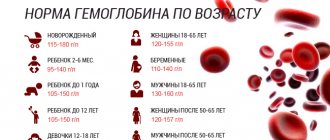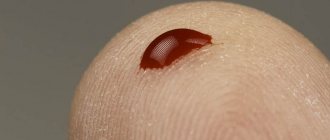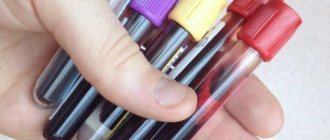What is hemoglobin?
Blood is a liquid substance that is distributed throughout the body through blood vessels. It performs transport functions, carrying nutrients, carbon dioxide and oxygen to various organs. In composition, it is plasma, which is a liquid medium in which cells - red blood cells, white blood cells and platelets - are suspended.
Red blood cells contain hemoglobin, which contains iron. It gives the blood a scarlet color and can reversibly bind oxygen and carbon dioxide. Due to this, gases necessary for the functioning of the body are transported from the lungs to other organs through arteries and veins.
Structure of human blood with low hemoglobin
If there is not enough hemoglobin in the blood, then the process of exchange of carbon dioxide and oxygen occurs. Organs and tissues suffer from oxygen deficiency, and waste carbon dioxide is poorly excreted into the lungs.
Normal hemoglobin levels in women
You can determine the level of hemoglobin in the blood using a general blood test. In women, the norm is numbers from 120 to 140 g/l.
Women who abuse smoking have different hemoglobin values - up to 150 g/l. Among representatives of professional sports, one can also observe increased levels – up to 160 g/l. Doctors do not see this as a pathology and consider such variations to be normal.
Hemoglobin in pregnant women is determined on a different scale, depending on the trimester. In the first and third trimester of pregnancy, the norm is 110-120 g/l, in the second it will be 105-120 g/l. These numbers are associated with those special physiological processes that occur in the body of a woman preparing to become a mother. Since the amount of blood during this period increases by half.
Iron deficiency anemia during pregnancy
Pregnancy is a special condition during which the female body undergoes changes and does not always cope with the load. As the fetus develops and grows, the volume of circulating blood also increases. It naturally thins to normalize circulation, resulting in a decrease in hemoglobin levels.
There is a concept of anemia in pregnant women. To prevent pathology, iron levels are monitored throughout pregnancy. There are three degrees of severity of iron deficiency anemia:
- mild – hemoglobin level 90-110 g/l;
- average – 80-90 g/l;
- deadly - the indicator drops below 80 g/l.
Laboratory data are clinically confirmed by the following symptoms:
- weakness;
- dizziness;
- digestive disorders;
- pronounced pallor.
Remember: low hemoglobin levels during pregnancy are especially dangerous!
Iron deficiency anemia is a common companion of pregnant women.
What level of hemoglobin is considered critical during pregnancy? Throughout the entire period, the child receives the necessary nutrients from the mother’s body. It must be taken into account that for full development it is necessary to consume an increased amount of vitamins and minerals, since deviations from the norm pose a danger to the development of the baby.
Another reason for the development of pathology is complications during childbirth, resulting in significant blood loss.
In severe cases, in order to increase the chance of the fetus to survive, critical hemoglobin is adjusted in all possible ways.
Symptoms of low hemoglobin
Symptoms indicating low hemoglobin levels can be asthenic and dystrophic.
Asthenic symptoms:
- Weakness.
- Fast fatiguability.
- Drowsiness.
- Dizziness.
- Decreased blood pressure.
- Headache.
- Heartbeat.
- Fainting.
These symptoms can be identified independently, without resorting to a special medical examination or visiting a doctor.
Dystrophic symptoms:
- Dry skin.
- Brittle and dry nails.
- Slow hair growth, dryness, fragility, loss.
- Changes in taste and smell.
Symptoms of low hemoglobin in the blood
Low hemoglobin can be one of the symptoms of various diseases. For example, the gastrointestinal tract is chronic atrophic gastritis, intestinal inflammation and dysbiosis. Infectious lesions - hepatitis, pneumonia, tuberculosis, kidney disease.
Among these diagnoses there may be diseases associated with impaired immunity - rheumatoid arthritis, glomerulonephritis, various malignant tumors.
Symptoms
Among the main signs of low hemoglobin are dizziness, pale skin, weakness, drowsiness, headaches, low blood pressure, and lack of appetite. A person constantly feels tired and wants to rest, sleep, and warm up. The skin may be cold to the touch. An unhealthy appearance appears with a lack of natural pink tones in the skin.
Frequent viral diseases, muscle pain, tinnitus and cold extremities (arms and legs) can also be symptoms of changes in blood hemoglobin levels. And if you have at least one of the above signs, you should consult a doctor to get a referral for a blood test, which will show all the main indicators, including hemoglobin.
Causes of low hemoglobin
Low hemoglobin in women: causes and consequences are clearly interrelated. There are 3 main reasons for lack of hemoglobin. First of all, there is a deficiency of iron in the body. After all, it is this microelement that is actively consumed during the synthesis of hemoglobin.
Low hemoglobin in women: causes and consequences
The second serious reason is bleeding. They can be large, during operations, injuries, childbirth, etc. So insignificant, hidden. For example, small but constant blood loss due to a stomach ulcer.
The third reason is when the body is unable to absorb iron from food. This happens when there is a lack of hemoglobin catalyst substances in the diet, these are vitamins B, PP and C.
Iron deficiency
Iron deficiency in the body is fraught with a wide variety of diseases. After all, this is a metabolic and immune disorder. Unfavorable changes occur in the mucous membranes, their barrier function is disrupted. As a result, infection easily penetrates the body, causing all kinds of disorders.
Therefore, a person suffering from iron deficiency most often falls ill with the flu, acute respiratory infections, which lead to serious complications - sinusitis, rhinitis. Diseases of internal organs, for example, various types of gastritis, can also occur. There is also a disturbance in cardiovascular activity - shortness of breath and tachycardia occur. Blood pressure decreases.
Functions of iron in the body
Problems are also detected on the part of the liver; it cannot fully perform its functions. Therefore, there is a decrease in blood glucose, albumin and prothrombin.
Iron deficiency is especially dangerous for pregnant women , because it causes placental insufficiency. The production of necessary hormones decreases, which negatively affects the formation and gestation of the fetus.
Blood loss
The reasons for low hemoglobin levels in the blood of women may be blood loss as a consequence of surgery, chronic diseases, etc. There are both extensive and very small, but chronic blood losses.
Rapid blood loss in large quantities provokes the occurrence of posthemorrhagic anemia. This can be various injuries and internal bleeding, for example, kidney, uterine, pulmonary, etc.
In this case, after 2 days, the blood volume in the body is restored, however, the number of leukocytes and hemoglobin is significantly reduced. After 4 days, the number of leukocytes and hemoglobin begins to increase, but at a slow pace. Therefore, during this period it is very important to support the body, give it the necessary amount of nutrients, and above all, iron.
Chronic anemia
Low hemoglobin content in the blood can occur in women due to constantly recurring small blood losses, which is fraught with serious consequences. For example, nosebleeds, heavy menstrual bleeding, stomach ulcers or hemorrhoids and other reasons. The result is a significant decrease in the level of iron and, accordingly, hemoglobin.
Erythropoiesis disorders
Erythropoiesis is the process of hematopoiesis. The consequence of impaired erythropoiesis is oxygen starvation of the body tissues, since it is distributed throughout the body in insufficient quantities. This leads to various kinds of diseases. This situation can arise as a result of chronic infectious processes, poisoning and intoxication, and malignant tumors.
The main cause of erythropoiesis is a deficiency of proteins, vitamin B12, folic acid and iron.
Accordingly, one of the consequences of this disorder is a decrease in hemoglobin and the number of red blood cells in the blood of women.
Increased destruction of red blood cells
Rapid destruction of red blood cells can occur as a result of poisoning, sepsis, and various serious infectious diseases such as malaria. The cause may also be skin lesions, burns and blood transfusion if it was of the wrong type.
In this case, red blood cells are destroyed faster than new ones can mature. This disease is called hemolytic anemia. There are two main types - intravascular and when the breakdown of red blood cells occurs outside the vascular system, in the bone marrow, lymph nodes, liver or spleen.
Lack of red blood cells in the blood causes anemia
With hemolytic anemia, the number of red blood cells and hemoglobin decreases, but iron increases. At the same time, active hematopoiesis continues in the bone marrow.
In some cases, in order to save a person from this problem, they even resort to surgery, removing the spleen.
Walks in the open air
Walking in the fresh air helps improve well-being and normalizes the functioning of the cardiovascular system. So don't forget to take regular walks to replenish your oxygen supplies.
The word “walk” should mean active walking, and not sitting on a bench with a newspaper. Walking in the fresh air is an excellent way to prevent anemia.
Reduced hemoglobin in pregnant women
During pregnancy, many changes occur in a woman's body, for example, blood volume increases significantly. However, the number of red blood cells decreases, and accordingly, the level of hemoglobin decreases during a certain period of pregnancy; this is a natural process.
Typically, a decrease in hemoglobin levels occurs after the 20th week of pregnancy, and before childbirth it is restored . Sometimes pathology can develop when hemoglobin begins to decrease too early and does not increase before childbirth.
The reasons for low hemoglobin in the blood of pregnant women can be many factors, and the consequences are always very unfavorable. In most cases, anemia is caused by an unbalanced diet that contains too little animal protein and iron.
At the same time, there is too much calcium, and it is this microelement that prevents the absorption of iron in the body. Among the unfavorable factors are hormonal imbalances, severe toxicosis, too short a period between pregnancies, when the woman’s body does not have time to fully recover.
Various types of chronic diseases and stress can also cause low hemoglobin in the blood of the expectant mother.
Iron supplements
You can increase hemoglobin in the blood using the above methods in the absence of serious health problems. In these cases, hemoglobin can be raised using the methods listed above, without resorting to medications. But in some cases, a specialist may prescribe iron supplements in tablets or injections. Most often in this case, Actiferrin, Hemofer, Ferronal, Totema, Tardiferron, Ferrlecit, Ferronate, Heferol, Hemohelper, Sorbifer, Ferlatum or Maltofer are prescribed.
Never self-medicate and take medications only as prescribed by your doctor. When taking them, the dosage is very important, taking into account individual characteristics, which can only be determined by a specialist based on the results of laboratory blood tests. Remember that iron supplements are usually taken in the afternoon, without chewing, an hour before meals. The following principles for taking iron supplements should be observed:
- do not take iron supplements together with Levomycetin, calcium supplements, Tetracycline, which interfere with the absorption of iron;
- while taking iron-containing medications, also take agents that improve iron absorption - vitamin C (ascorbic acid), sorbitol, succinic acid, as well as vitamins A, E, B1, B6;
- the dose of the drug must be strictly selected by calculation for each individual patient;
- the course of treatment should not be less than 1.5-2 months.
The effect of therapy depends on a number of factors and begins to appear after 3-4 weeks of treatment. And don’t forget that comprehensive measures will help increase hemoglobin. Therefore, carefully review not only your diet, but also your lifestyle - give up bad habits, sign up for a gym or swimming pool, do yoga or aerobic training. All this will have a positive effect and you will forget about weakness, tachycardia and begin to live a life full of strength and energy.
Drug-induced increase in hemoglobin
Treatment of iron deficiency anemia with medications is prescribed exclusively by a doctor. Because it is necessary to eliminate the cause of the problem, which may be impossible to determine on your own. Typically pharmaceuticals are used in the following cases:
- When, according to test results, a serious deviation of hemoglobin levels from the norm is noticed;
- When a special diet does not help and test results are still not satisfactory;
- When it is not possible to organize special medical nutrition;
- When a course of treatment with drugs that can affect the metabolism in the body is prescribed;
- When a major operation with possibly large blood loss is scheduled;
All medications have their own contraindications. In particular, these are certain diseases of the gastrointestinal tract, hypersensitivity to components, impaired removal of excess iron from the body, hemochromatosis.
Medications to increase hemoglobin levels are usually a complex of ferrous sulfate and vitamins. First of all, ascorbic acid, which improves the absorption of iron.
The main task of medications is to increase iron levels in the blood
Medicines are available in a variety of forms - tablets, chewable tablets, syrups and solutions for intramuscular use. The most commonly prescribed by doctors are sorbifer-durules, felyuls, ferrum lek and ferro-foil.
Vitamins for hemoglobin
To better absorb iron, it is recommended to provide the body with vitamin C. It is found in sufficient quantities in the following foods:
- rosehip;
- sweet bell pepper;
- lemon
The table below shows how much vitamin C is found in various foods:
Vitamin C content in food products (mg per 100 g)
| Product Name | Vitamin C content, mg/100g | Product Name | Vitamin C content, mg/100g |
| Vegetables | Fruits and berries | ||
| Eggplant | 5 | Apricots | 10 |
| Canned green peas | 10 | Oranges | 50 |
| Fresh green peas | 25 | Watermelon | 7 |
| Zucchini | 10 | Bananas | 10 |
| White cabbage | 40 | Cowberry | 15 |
| Sauerkraut | 20 | Grape | 4 |
| Cauliflower | 75 | Cherry | 15 |
| Potatoes are stale | 10 | Pomegranate | 5 |
| Freshly picked potatoes | 25 | Pear | 8 |
| Green onion | 27 | Melon | 20 |
| Carrot | 8 | Garden strawberries | 60 |
| cucumbers | 15 | Cranberry | 15 |
| Sweet green pepper | 125 | Gooseberry | 40 |
| Sweet red pepper | 250 | Lemons | 50 |
| Radish | 50 | Raspberries | 25 |
| Radish | 20 | Tangerines | 30 |
| Turnip | 20 | Peaches | 10 |
| Salad | 15 | Plum | 8 |
| Tomato juice | 15 | Red currants | 40 |
| Tomato paste | 25 | Black currant | 250 |
| Red tomatoes | 35 | Blueberry | 5 |
| Horseradish | 110-200 | Dried rose hips | Up to 1500 |
| Garlic | Footprints | Apples, Antonovka | 30 |
| Spinach | 30 | Northern apples | 20 |
| Sorrel | 60 | Southern apples | 5-10 |
| Dairy | |||
| Kumis | 20 | Mare's milk | 25 |
| Goat milk | 3 | Cow's milk | 2 |
As you can see, the absolute champions for vitamin C content are rose hips, black currants, red bell peppers and horseradish. In some cases, additional vitamin C or vitamin B12 is prescribed in tablets or injections. Typically, such vitamin therapy takes 1.5-2 months. If the desired effect is not achieved, the use is extended for another couple of months, slightly reducing the dosage.
Increasing hemoglobin with folk remedies
Traditional recipes do not contain harmful substances in their composition and have virtually no contraindications. Natural plant components are easily absorbed by the body, so the increase in hemoglobin levels occurs quite quickly.
Traditional recipes have already been tested by thousands of people , their composition has been determined experimentally, and medical professionals have confirmed their effectiveness. Often it is doctors who advise adding some folk remedies in addition to drug treatment to enhance the effect.
Natural traditional medicine is especially good for pregnant women. Since some pharmaceutical drugs have corresponding contraindications, and therefore are not recommended for expectant mothers.
Recipe with honey, dried fruits and lemon
Dried fruits - prunes, apricots, raisins - contain a large amount of useful substances that can prevent iron deficiency anemia. This is a wonderful source of vitamins, beneficial acids and microelements.
Lemon is very rich in vitamin C, a powerful antioxidant that can help with anemia to quickly absorb essential microelements.
Raising your hemoglobin levels can feel good
Honey is an additional source of nutrients necessary to support a woman’s body. Eliminate unpleasant symptoms of anemia, such as low blood pressure.
The mixture of these three ingredients tastes very pleasant and gives a positive mood, which is important for a quick recovery. And the composition of this wonderful folk remedy is significantly superior to any pharmaceutical medicine.
It is easy to prepare: a well-washed lemon along with the peel is crushed in a meat grinder. Then add a glass of raisins, dried apricots and prunes to the lemon. Next, this mixture is poured with honey. You can store it in the refrigerator in a glass container and use it every day instead of sweets with tea. You can add it to various dishes - porridge, muesli, cottage cheese.
Rosehip infusion
Rosehip contains many substances that stimulate hematopoiesis and increase the iron content in the body. Red fruits are especially known for their high levels of vitamins B and C - ascorbic acid, which enhances the absorption of beneficial microelements, in particular iron.
Brewed rosehip
Other organic acids that are part of rose hips also have a beneficial effect on the absorption process.
There are two ways to brew dried berries.
- First way. You will need a thermos or enamel container with a lid. Pour a glass of boiling water over a tablespoon of dry berries and leave for 4 hours. Then a glass of infusion is filtered and taken before meals. You should triple the dose so that the infusion is enough for one day, and you can steam it overnight.
- Second way. Mash fresh rose hips and pour a glass of boiling water over a tablespoon of the prepared gruel. The infusion is kept for half an hour, then filtered. It should be consumed with honey.
Composition of cranberries, honey and nuts
Cranberries are a very healthy berry, as they contain not only a large amount of iron, but also vitamin C, which contributes to better absorption of this microelement.
Honey will add additional vitamins to this wonderful, tasty and healthy folk remedy, helping to increase not only hemoglobin, but also the body’s resistance to various diseases. Thus, it will enhance the effect of cranberries.
Walnuts are a storehouse of microelements; they also contain a fairly large amount of natural iron, which will be quickly absorbed by the body. Therefore, a mixture of cranberries, honey and nuts will be no less effective than any medication, but at the same time absolutely safe, especially for expectant mothers.
All three ingredients must be taken in equal quantities. Pre-grind the nuts in a coffee grinder, meat grinder or blender. Add cranberries and honey, mix thoroughly. You can store the mixture in the refrigerator.
It should be consumed several times a day, one or two teaspoons . Add to morning porridge and eat instead of sweets, washed down with tea or herbal infusion.
Kefir and buckwheat
Buckwheat helps to quickly increase hemoglobin and forget about anemia. This is an extremely simple, but at the same time very tasty remedy.
You need raw buckwheat, which should be ground into flour in a meat grinder or using a coffee grinder. You need to consume the resulting buckwheat flour 2 tablespoons in the morning and evening with a full glass of apple juice, preferably natural, freshly squeezed. Buckwheat flour can be stirred in a glass of juice.
Instead of apple juice, you can use kefir or fermented milk. This will help the gastrointestinal tract quickly digest buckwheat flour and fully absorb the microelements it contains, and above all iron.
Infusion of buckwheat flowers
Buckwheat flowers are extremely effective for iron deficiency, because this folk remedy even helps with leukemia and radiation sickness.
To prepare the infusion, you need a tablespoon of buckwheat flowers, pour 2 cups of boiling water. Next, prepare the infusion in a water bath for 20 minutes, then remove the container from the steam and leave for 40 minutes to saturate. Then you need to strain the liquid through cotton cloth or gauze, folded several times.
You need to drink the resulting infusion before meals 3 times a day, 150 ml. During preparation, along with buckwheat flowers, you can add other useful herbs to the infusion - blackberry leaves, nettle leaves, dandelion root. This will greatly enhance the effect.
There is another, simple way to prepare a healthy infusion. Together with other herbs, buckwheat flowers are poured into a thermos and filled with a glass of boiling water, and the cap is tightly closed. After 2 hours, the infusion is ready, it can be consumed half a glass 2 times a day.
Acorns
Preparing a folk remedy to increase hemoglobin levels from acorns will require some effort and time. First, the acorns should be broken and thoroughly peeled from the hard skin. The cores must be ground in a meat grinder.
Next, a glass of the resulting powder should be filled with 2 glasses of water. It is necessary to cook over low heat, stirring, until the consistency of a slurry is obtained. After cooling, the product should be placed on a cotton cloth, leveled and left to dry. Next, the dry mass needs to be fried in a well-heated frying pan and then, after cooling, grind again to a fine powder.
A drink made from ground acorns increases hemoglobin
A special drink should be prepared from the resulting powder. Pour a tablespoon of acorn powder into a glass of milk and boil for several minutes. This mixture should be taken 3 times a day before meals, 2 tablespoons .
Beet and carrot juice
Carrots and beets are very useful for iron deficiency anemia. These vegetables should be eaten both raw, in salads, and boiled. However, their freshly squeezed juice is especially good for a quick effect.
This juice cannot be stored for a long time, even in the refrigerator. Therefore, it is preferable to consume it immediately after preparation or within 5 hours. Freshly squeezed carrot and beet juice are mixed together in a 1:1 ratio. It is better to take it slightly diluted with water, since the juice turns out to be too concentrated and tart in taste.
It is better to drink it 20 minutes before meals or 60 minutes after meals. You should drink at least 2 glasses of juice per day, dividing the intake into 2-3 times.
Pomegranate juice
Pomegranate is extremely effective for iron deficiency anemia; it is especially good to use after blood loss. It quickly restores not only hemoglobin, but also promotes hematopoiesis. Pomegranate berries can be consumed at any time of the day, every day.
However, the most suitable way is freshly squeezed pomegranate juice. In this case, it is best to use the whole fruit, including the peel, by first chopping it in a meat grinder. Then squeeze out the juice, since the skin and pulp of the pomegranate contain a large amount of useful substances that promote the rapid absorption of iron in the body.
Benefits of pomegranate
The resulting juice will be concentrated, so it is better to dilute it with water by 50% . You can use carrot and beet juice instead of water to enhance the effect. You should drink pomegranate juice a little before meals, 10 minutes per tablespoon.
You can also prepare a healthy mixture by mixing a tablespoon of pomegranate and lemon juice, and then adding 2 tablespoons of honey. This mixture should be consumed 2 times a day, 2 tablespoons, washed down with soda or diluted in a small amount.
Nuts with honey and lemon for hemoglobin
For iron deficiency, a mixture of walnuts, dried fruits, honey and lemon helps very well.
To prepare this mixture, take two hundred grams of dried apricots, walnuts, raisins, prunes, and one lemon along with zest. Mix all ingredients and pass through a meat grinder. Fill with honey. Take one tablespoon three times a day.
How to increase hemoglobin with diet?
You can quickly increase the level of hemoglobin in the blood with the help of a special diet. Moreover, it is important not just to consume as many foods as possible that contain large amounts of iron. The main thing is to choose the right food ingredients in the optimal combination that will help the body most fully and easily absorb this essential microelement.
A large amount of iron is included in meat, especially liver and veal - up to 22%.
Approximately 11% of iron can be obtained from seafood. Plant foods contain only 5% of the essential microelement.
However, it has a very important quality - vitamins that will help absorb it.
Therefore, you must include cabbage, strawberries, citrus fruits, pomegranates, watermelons and peaches, apples and pumpkin in your diet. It’s good to add legumes, which not only have a fairly high iron content, but also accompanying substances, valuable proteins and vitamins.
Iron-rich foods
There are two groups of iron that are well absorbed in the body - heme and non-heme forms. Heme iron is better absorbed; it is the source for the formation of hemoglobin in the blood . It is found in animal products, which have a high protein content, and not heme - in plant products.
Sources of iron
Animal foods that contain the highest amounts of iron:
- liver;
- beef and veal;
- pork;
- turkey;
- egg yolk;
- fish – pink salmon, mackerel, sardines, anchovies;
- seafood - oysters, mussels, clams;
Plant foods with the highest iron content:
- nuts;
- pumpkin seeds;
- sesame;
- buckwheat;
- lentils;
- beans;
- fruits: apricots, pomegranates, plums, apples, sea buckthorn, rose hips.
Foods rich in folic acid
Folic acid is important for hematopoiesis and the formation of leukocytes in the bone marrow. Therefore, its deficiency is one of the indirect causes of iron deficiency anemia and a decrease in hemoglobin.
The daily intake of folic acid for pregnant women is 600 mcg/day.
Vegetables, fruits, eggs, liver, cereals and whole grain bread are rich in folic acid.
You can replenish the supply of this very important substance in the body by eating the following foods:
- fresh herbs;
- legumes;
- cabbage, especially broccoli and cauliflower;
- carrot;
- pumpkin;
- beets and turnips;
- asparagus;
- citrus fruits - especially oranges and lemons;
- pears and apples;
- apricots;
- berries - strawberries and currants;
- buckwheat;
- rye – whole grain rye bread;
- nuts of all kinds;
- seeds – sesame, pumpkin, sunflower;
- watermelons;
- tomatoes;
- corn;
- avocado;
- liver, including cod liver;
- eggs – chicken, quail, goose, duck;
- cereals – buckwheat, oatmeal, barley, pearl barley;
Dietary restrictions for anemia
If you have anemia, you should not only include foods high in iron in your daily diet, but also try to avoid certain foods while your blood hemoglobin levels are restored to normal. During treatment, it is not recommended to drink strong tea and coffee, as they wash iron and calcium from the body. Foods containing large amounts of calcium slow down the absorption of iron. Therefore, cottage cheese, milk and cereals should be consumed separately from meat. In order for the iron that enters our body with food to be better absorbed, attention should be paid to vitamins.
Dangerous consequences of decreased hemoglobin
The consequences of a decrease in hemoglobin in the blood of women can be dangerous and lead to death, even though the cause at first seems insignificant. First of all, the immune system is impaired, the body becomes vulnerable to all kinds of infections and complications.
Internal organs - the liver, spleen - cease to perform their functions effectively, wear out quickly, and increase in size. The heart is under significant strain due to lack of oxygen. It begins to work hard, moving blood faster to saturate the tissues with oxygen. The result is heart failure.
Chronic heart failure
The greatest danger of decreased hemoglobin is for pregnant women. Because fetal development may be impaired as a result.











